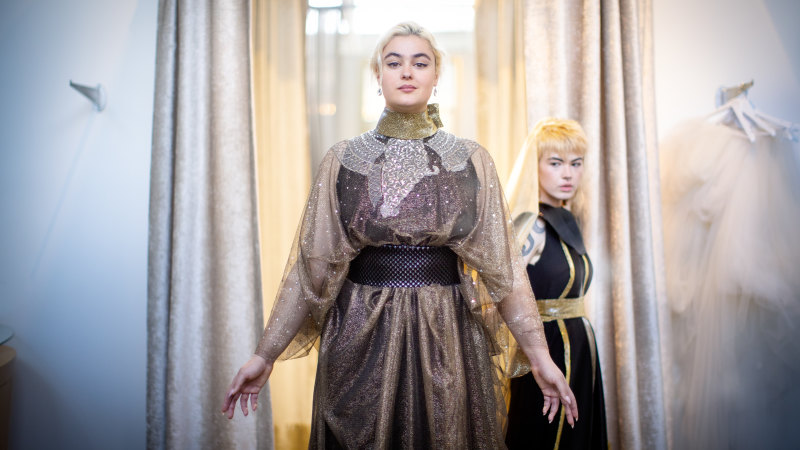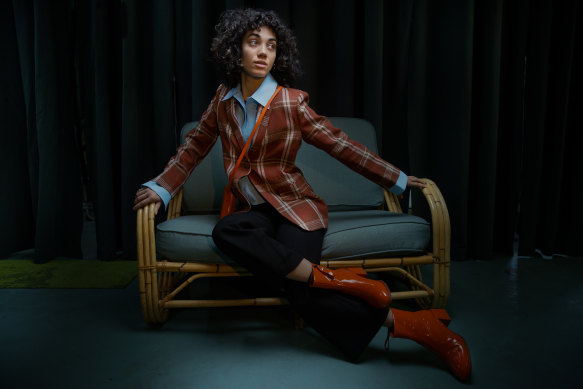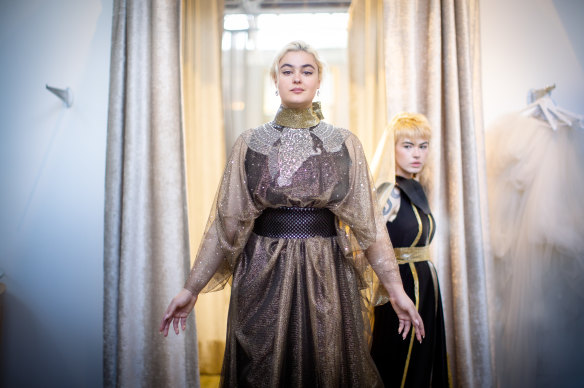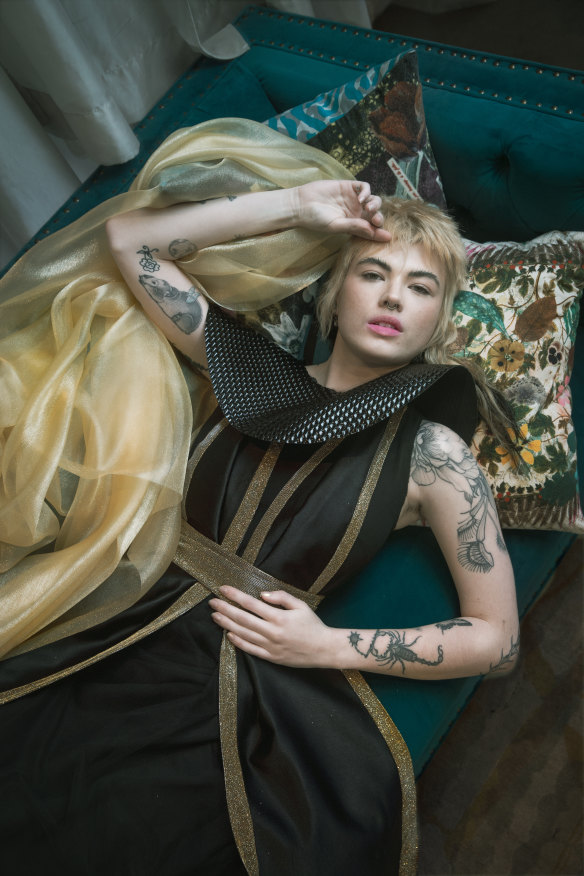Save articles for later
Add articles to your saved list and come back to them any time.
Designer fashion has had no problem going digital. Sims have had wardrobes filled with Moschino, Fortnite characters have battled to the death in Polo Ralph Lauren and Animal Crossing villagers have tended their gardens while clad in Valentino.
However, on the flip side, video games have not quite infiltrated the fashion world in real life. While artificial intelligence and machine learning tools have helped digitise high-end fashion, the look and style of video game characters are barely ever seen on runways.
Bella Model Cièna wearing Virginia Martin Bul’s design, which is inspired by Stray Gods character, Freddie. Credit: Simon Schluter
Managing director of video game developer Summerfall Studios Liam Esler says video games’ minor influence on fashion is surprising considering the popularity and scope of gaming – a multi-billion dollar industry, which is dominating entertainment spaces globally.
“Video games are like movies in the sense that they rarely influence fashion – many assume they just reflect a specific existing vision of fashion,” Esler says. “But there’s this whole world out there for people to explore, where games can help to influence that element of popular culture.”
Enter Stray Gods: The Roleplaying Musical. This Australian-made adventure game, released in August, has inspired its very own fashion runway show, set to take place during Creative Victoria’s Big Games Night Out. Eight Melbourne designers will each showcase two designs: an exact replica of a Stray Gods character costume and an elevated “real world” version of the same character’s look – aka how the designer envisions they would dress if they were in our reality.
From pixels to textiles
This is the first time Virginia Martin, founder of womenswear label Búl, has created designs inspired by a video game character, which in her case was Freddie, a “mythology nerd” who is close friends with the game’s main character.
“It’s very different. You’re curating an outfit based on someone’s identity rather than it being commercially driven, so there’s no limit to what you can design. The virtual world becomes your oyster.”
Though it’s a new concept for her, she says fashion and video games are well suited to each other. “It’s a visual medium and people like to interact with media that displays good fashion and innovation. We designers have the ability to portray a certain character through our designs, so it makes sense that fashion designers are a great – yet untapped – resource for the video games industry.”
Sonia Cappellazzo, managing director of Cappellazzo Couture, agrees. While designing the outfits for Hecate, goddess of witchcraft and magic, she says it needed to be couture and wearable, but also able to capture the character’s energy. She describes the process as bringing the “Gods to live among mortals”.
“It’s realistic, but also fantastical,” Cappellazzo says. “The fashion is taking [the characters] out of the screen for players to see alive and mobile, so there is a stronger connection.”
Cosplay 2.0
Video game fashion has not been entirely absent from the mainstream. Chains like Target sell T-shirts and hoodies (streetwear) printed with Fortnite or Pokémon logos, Cappellazzo says, but this is generally a branded collaboration rather than a curated design inspired by either a character or the virtual world of a game.
Bella Models’ Stefania (left) and Jonti (right) wearing Sonia Cappellazzo’s designs for the Stray Gods character, Hecate.Credit: Simon Schluter
There’s also cosplay, which has become particularly popular thanks to gaming conventions like Comic-Con. However, Summerfall Studio’s marketing director, Meredith Hall, says most cosplay doesn’t translate easily into everyday wear.
“Most cosplay outfits involve characters that are from fantasy worlds. They’re larger than life, or have a lot of equipment and aren’t necessarily outfits you can buy and put together easily. You have to be really across how to build the look because cosplay is an art in itself.”
Hall believes events like the Stray Gods fashion show could make video game fashion more accessible, demonstrating to gamers and non-gamers alike how grandiose costumes can be translated to stylish everyday outfits, as well as high-end couture.
It’s like the gaming version of “Disneybounding”, Hall says, which is when people use everyday pieces to resemble a Disney character – albeit slightly elevated to suit designer tastes in Stray Gods′ case. For example, Cappellazzo notes her exaggeration of volume and use of quality fabrics when designing the Hecate outfits.
The Stray Gods fashion show will be one of the first times video game fashion is brought to a physical runway.Credit: Simon Schluter
Changing dress codes
Virginia Dowzer, a creative developer behind the Stray Gods fashion show, says video game fashion can help people develop their own unique visual identities, as they’re inspired to wear clothing that differs from the trends displayed in shop windows.
“Everyone wants to stand out now,” Dowzer says. “It’s much more avant-garde than it has been, people are pushing boundaries.”
Cappellazzo says the fashion they’re creating allows players to escape into their favourite characters, to embody their mythological confidence and strengths without having to resemble them identically.
Consoles meet catwalks
Certain labels have already bridged the gap between digital fashion and real-world runways, such as Sydney’s Injury, which has curated a series of digital and “phy-gital” runways (shows that integrate both physical and technological elements). Marc Jacques Burton, who founded the fashion label MJB, collaborated with the first-person shooter game Overwatch 2, curating a capsule clothing collection based on the game’s characters.
But Dowzer says the Stray Gods event – which will also feature designs from HoMie, Paul McCann, Eric Yvon, Mr Cuff, Mndatory and Victoria Triantafyllou – is one of the first physical runways directly inspired by a game, noting that it appeals to both fashionistas and gamers.
“Anyone can appreciate a three-dimensional person in the real, even if you don’t identify with what they’re wearing. You can still look at them and go, ‘wow, they look amazing. Maybe I’d never wear it, but they look great’. This allows the designers to really push the boundary between virtual and physical.”
As AI becomes ever-present and art increasingly digitised, Martin says it’s refreshing to see virtual ideas brought to life in our tangible world, almost like tracing back to our creative roots.
“Inspiration can come from anywhere, so it’s great to be able to showcase the viability of gaming fashion.”
Big Games Night Out will take place on October 5 and is part of Melbourne International Games Week, which is delivered by Creative Victoria between September 30 to October 8.
Make the most of your health, relationships, fitness and nutrition with our Live Well newsletter. Get it in your inbox every Monday.
Most Viewed in Lifestyle
From our partners
Source: Read Full Article



